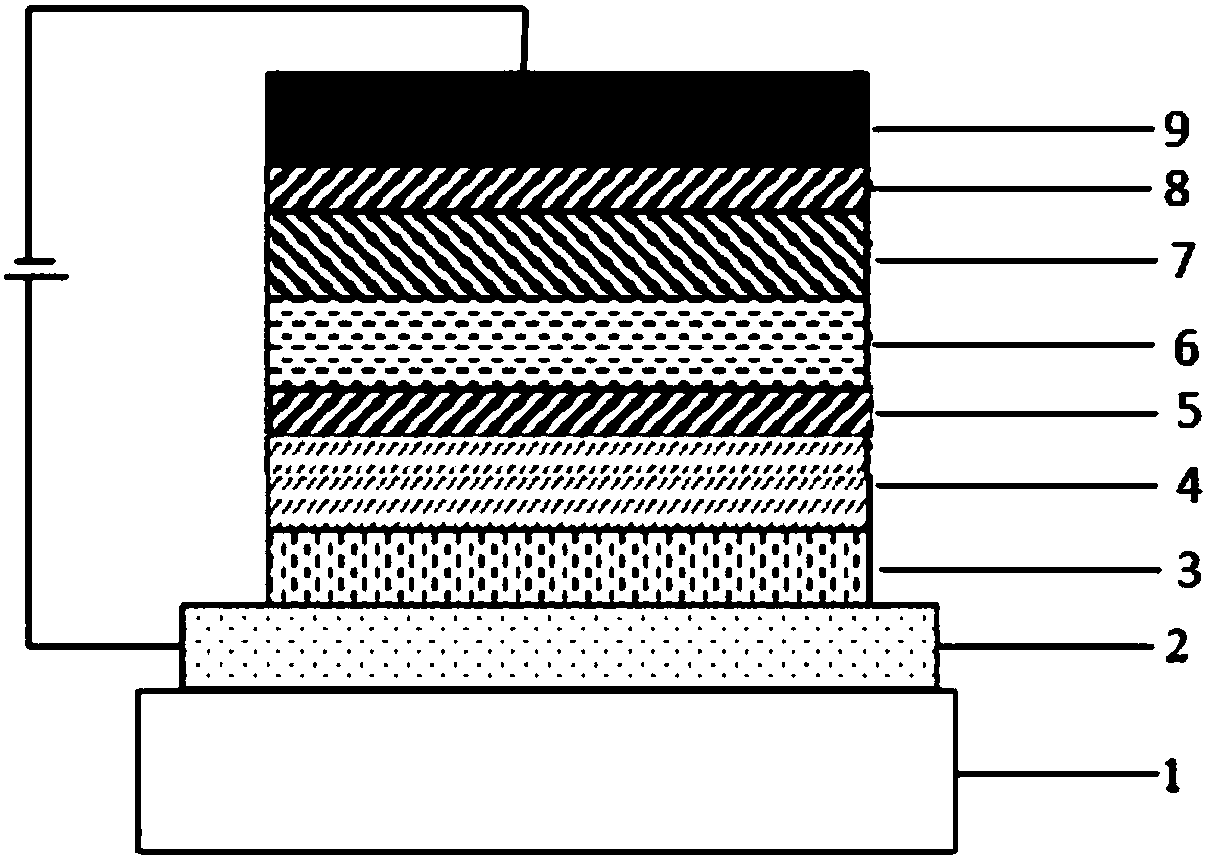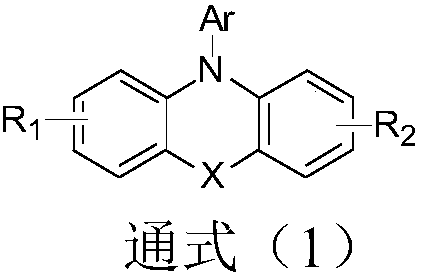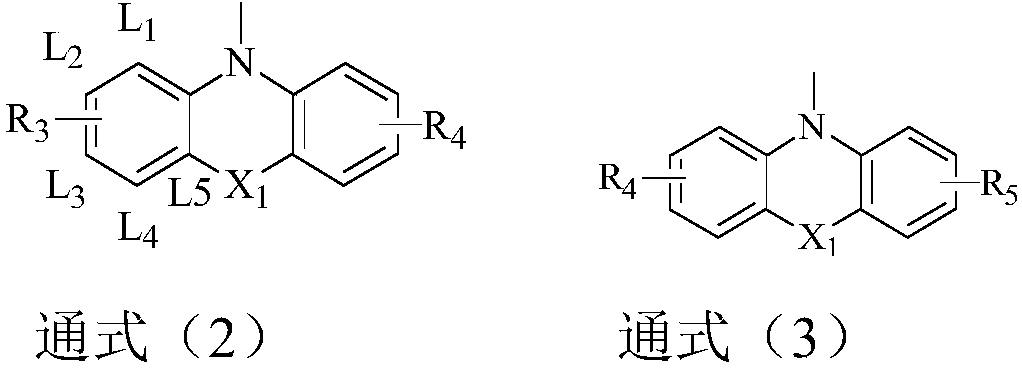Compounds adopting dibenzo six-membered heterocyclic rings as cores and applications thereof
A technology of six-membered heterocycles and compounds, which is applied in the application field of organic compounds and organic electroluminescent devices, can solve problems such as performance differences, achieve high glass transition temperature, improve current efficiency and life, and reduce efficiency roll-off Effect
- Summary
- Abstract
- Description
- Claims
- Application Information
AI Technical Summary
Problems solved by technology
Method used
Image
Examples
Embodiment 1
[0048] Embodiment 1: the synthesis of compound 3:
[0049] synthetic route:
[0050]
[0051] In a 250mL three-neck flask, under nitrogen atmosphere, add 0.02mol 2-bromo-10-H-phenoxazine, 0.03mol bromobenzene, 0.04mol sodium tert-butoxide, 10 -4 mol Pd 2 (dba) 3 , 10 -4 mol P(t-Bu) 3 and 200mL of toluene, heated to reflux for 10 hours, sampled and spotted, the raw materials reacted completely; naturally cooled to room temperature (20-25°C), filtered, and the filtrate was collected for vacuum rotary evaporation (-0.09MPa, 85°C), and column chromatography , to obtain raw material A1.
[0052] In a 250mL three-neck flask, under nitrogen protection, add 0.03mol 3-bromophenazine, 0.036mol 9,9-dimethylacridine, 150mL toluene and stir to mix, then add 0.09mol sodium tert-butoxide, 0.015mol Pd 2 (dba) 3 , 0.015mol tri-tert-butylphosphine, heated to 120°C, and refluxed for 24 hours; naturally cooled to room temperature, filtered, and the filtrate was subjected to vacuum rotar...
Embodiment 2
[0056] Embodiment 2: the synthesis of compound 6:
[0057] synthetic route:
[0058]
[0059] In a 250mL three-necked flask, under nitrogen protection, add 0.03mol 2-bromo-9,9-dimethylacridine, 0.036mol carbazole, 150mL toluene and stir to mix, then add 0.09mol sodium tert-butoxide, 0.015mol PD 2 (dba) 3 , 0.015mol tri-tert-butylphosphine, heated to 120°C, and refluxed for 24 hours; naturally cooled to room temperature, filtered, and the filtrate was subjected to vacuum rotary evaporation (-0.09MPa, 85°C), and passed through a neutral silica gel column to obtain the intermediate M2;
[0060] Weigh 0.01mol of the above-obtained intermediate M2 and 0.015mol of raw material A1 and dissolve them in 150mL of anhydrous toluene, add 0.02mol of sodium tert-butoxide and 10 -4 mol Pd(dppf)Cl 2 , heated to reflux for 15 hours, sampling point plate, the raw material reacted completely; naturally cooled to room temperature (20 ~ 25 ° C), filtered, collected the filtrate and carried...
Embodiment 3
[0063] Embodiment 3: the synthesis of compound 16:
[0064] synthetic route:
[0065]
[0066] In a 250mL three-neck flask, under nitrogen protection, add 0.03mol 3-bromophenazine, 0.036mol carbazole, 150mL toluene and stir to mix, then add 0.09mol sodium tert-butoxide, 0.015mol Pd 2 (dba) 3 , 0.015mol tri-tert-butylphosphine, heated to 120°C, and refluxed for 24 hours; naturally cooled to room temperature, filtered, and the filtrate was subjected to vacuum rotary evaporation (-0.09MPa, 85°C), and passed through a neutral silica gel column to obtain the intermediate M2;
[0067] Weigh 0.01mol of intermediate M3 obtained above and 0.015mol of raw material A1 and dissolve in 150mL of anhydrous toluene, add 0.02mol of sodium tert-butoxide and 10 -4 mol Pd(dppf)Cl 2 , heated to reflux for 15 hours, sampling point plate, the raw material reacted completely; naturally cooled to room temperature (20 ~ 25 ° C), filtered, collected the filtrate and carried out vacuum rotary evap...
PUM
| Property | Measurement | Unit |
|---|---|---|
| thickness | aaaaa | aaaaa |
| thickness | aaaaa | aaaaa |
| thickness | aaaaa | aaaaa |
Abstract
Description
Claims
Application Information
 Login to View More
Login to View More - R&D
- Intellectual Property
- Life Sciences
- Materials
- Tech Scout
- Unparalleled Data Quality
- Higher Quality Content
- 60% Fewer Hallucinations
Browse by: Latest US Patents, China's latest patents, Technical Efficacy Thesaurus, Application Domain, Technology Topic, Popular Technical Reports.
© 2025 PatSnap. All rights reserved.Legal|Privacy policy|Modern Slavery Act Transparency Statement|Sitemap|About US| Contact US: help@patsnap.com



